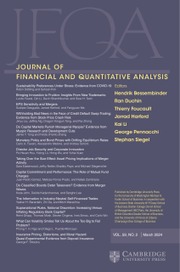No CrossRef data available.
Article contents
Stealth Mergers and Investment Outcomes
Published online by Cambridge University Press: 08 April 2025
Abstract
“Stealth mergers” are not reported to the government because they fall below the required size threshold. We study stealth mergers involving public targets for which manipulation of transaction sizes is unlikely. These stealth mergers result in less R&D spending, patenting, and capital expenditures, and in lower value patents for both acquiring firms and their competitors relative to non-stealth mergers. Industry concentration increases, and product market competition decreases for stealth acquirers. Stealth acquirers and their competitors earn higher cumulative abnormal returns relative to non-stealth mergers. Our results suggest more government scrutiny is warranted for stealth mergers.
- Type
- Research Article
- Information
- Creative Commons
- This is an Open Access article, distributed under the terms of the Creative Commons Attribution licence (http://creativecommons.org/licenses/by/4.0), which permits unrestricted re-use, distribution and reproduction, provided the original article is properly cited.
- Copyright
- © The Author(s), 2025. Published by Cambridge University Press on behalf of the Michael G. Foster School of Business, University of Washington
Footnotes
We thank Mara Faccio (the editor), the referee, German Gutierrez (discussant), Gordon Phillips, Jerry Hoberg, Simcha Barkai and the seminar audiences at the 2023 American Finance Association Annual Meeting, Northeastern University, Boston College, and the Virtual Finance Conference hosted by the Finance, Organizations and Markets Group at Dartmouth College for helpful comments. Any views expressed are those of the authors and not those of the U.S. Census Bureau. The Census Bureau’s Disclosure Review Board and Disclosure Avoidance Officers have reviewed this information product for unauthorized disclosure of confidential information and have approved the disclosure avoidance practices applied to this release. All errors are our own.
Funding: This research was performed at a Federal Statistical Research Data Center under FSRDC Project Number 2565 (CBDRB-FY22-P2565-R9892).


